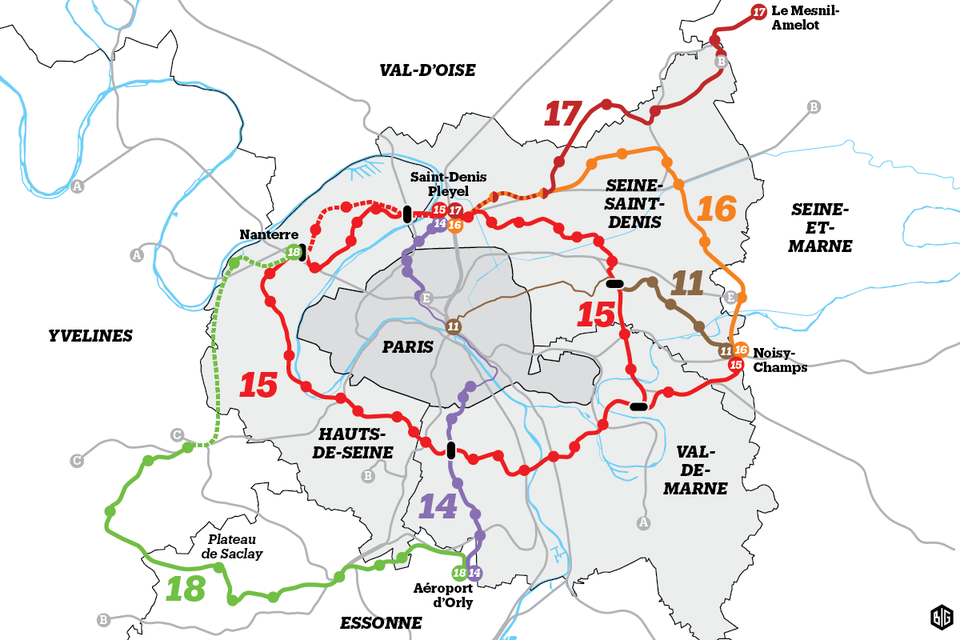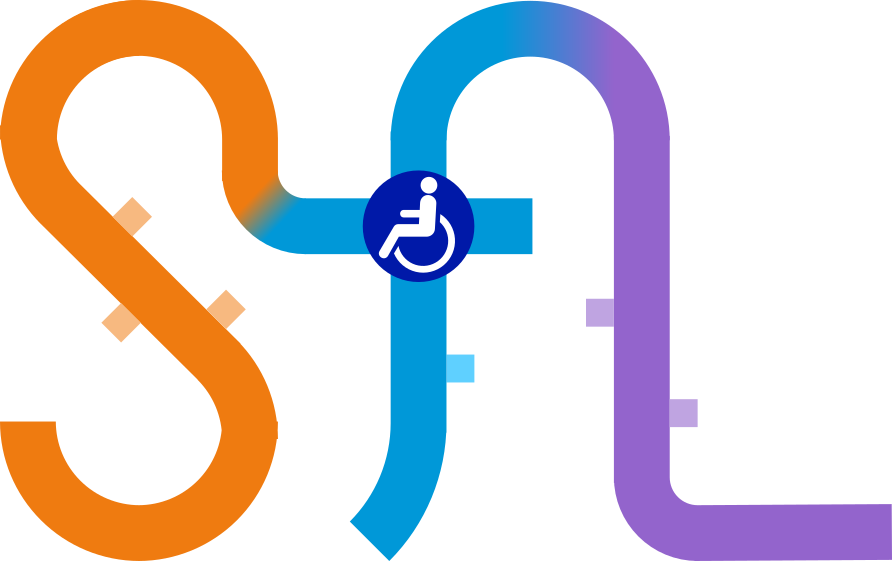Jon and I are currently on our way down to Barcelona for our week-long honeymoon trip in Barcelona. Rather than dealing with the hassle of flying and worrying about whether Jon’s wheelchair would make it in one piece, we decided to take the train to experience the joys of high-speed rail. The journey is divided into three parts: London to Paris via Eurostar, a cross-city bus between the Paris terminals, and Paris to Barcelona via TGV. This post will mainly focus on accessibility in and around Paris as well as the issues that we had while planning our route, while the next will cover accessibility in Barcelona.
As I mentioned before in some earlier post, Paris is shockingly disappointing in terms on rail transport accessibility. Paris itself has a robust rail network composed of an extremely dense metro network (Metro), a series of 5 Crossrail-like suburban lines (RER) that offer quick access through the city centre, conventional suburban lines centred around the various Paris terminal stations, and a growing orbital tram/light rail network that links together the vast Parisian suburbs. The map below shows all the lines inside zone 1 of the rail network, which corresponds to the limits of the City of Paris and is size-wise between zones 1 and 2 in London.

Despite this comprehensive system, where a station is always a short walk away within the city limits (and where sometimes walking is indeed a faster alternative given that the average distance between stations on the Metro is 562 metres), when you factor in accessibility, the chaotic and spaghetti-like map becomes this:

What’s left is the inner lines of the tram network, which were built in recent years and are fully accessible, a single Metro line, and portions of the RER network that require ramp assistance and even prior booking. Compare that to a similar area in London:

While far from perfect, London’s central network is beginning to take shape in terms of accessibility and has made important progress in recent years. Keeping this in mind, I will now briefly go over the main characteristics of the Metro and RER.
Metro
On the Metro, only the newest line, Line 14, is fully accessible to the trains. While the first segment of the Metro opened in 1900 and the core network of the first 13 lines (including the 3b and 7b branches) was in place by the 1930’s, Line 14 opened in 1998 with 9 stations and was built with accessibility in mind.

The rest of the network, except for the newest extensions to the suburbs (around 6 stations), remains completely inaccessible for anyone requiring step-free access. Since there are a total of 303 Metro stations, this situation is quite disgraceful. Due to its age, the excuse for not adapting the Metro network has always been that it is simply too expensive and challenging, with estimates citing €4-6 billion to make the whole system accessible. Instead, Paris urges disabled passengers to use buses, noting that most of the network is now fully accessible, with automatic ramps as in London.
I find these excuses and this mentality completely unacceptable. Not only is the London Underground much older than the Paris Metro, but it is becoming accessible in a piece-wise fashion, prioritising stations according to their complexity and passenger numbers. Just because adapting the WHOLE network is expensive does not mean that nothing should be done. In fact, it seems like Paris went out of its way to avoid this issue.
When Line 14 was built, which was around the same time the Jubilee Line Extension opened, no one thought to take the opportunity to adapt all of the interchanges with other lines. Similarly, when Line 1 was fitted with platform-edge doors and driverless operation, which removed the step and gap between the train and platform at every station, the stations remained inaccessible to the surface.
Transport officials do like to stress that all future Metro extension lines will be fully accessible. Indeed, there is an ambitious plan to expand Lines 11 and 14 and add 4 new lines within the next 10-15 to improve mobility between the suburbs. So will these new lines finally bring adequate accessibility to residents and tourists hoping to explore the City of Lights???

…Not quite. While the programme, called the Paris Grand Express, is very important and will unite Paris with its neglected suburbs, the fact that virtually the entire programme is outside of Paris means that there will be no change in Paris’s inaccessibility in the near future. It seems like there is only one thing that could possibly change this grim situation.
2024 Olympic Games
Paris is hosting the 2024 Olympic and, most importantly, Paralympic Games. If history is any guide, hosting the Games brings an extreme pressure to improve the accessibility of a city’s infrastructure. Indeed, the 2012 Olympics were the catalyst that kickstarted London’s slow journey towards increased accessibility. For now, the only sign that anything may change is an announcement from the Council of Paris to the Regional Council of Ile-de-France demanding feasibility studies into making the Metro partially accessible, with an emphasis on major interchanges. Whether or not this leads to something concrete is yet to be seen, but I hope that Paris will use this moment to overhaul its aging system and make it fit-for-purpose.
RER
After getting to Gare du Nord in Paris on Eurostar, the next step was to make our way to Gare de Lyon to catch our train to Barcelona. Being a rail enthusiast, I was aware of the Metro’s lack of accessibility before planning our journey, so I never considered it a viable option. Instead, I had initially planned for us to get there using RER D, which serves both stations. I had checked that both stations had lifts down to platforms and was reassured that there would be ramps available.
And so, Jon and I went on a day trip to Paris in July to check out this option as well as other alternatives. However, after navigating the absolute mess that is Gare du Nord for an hour, with its undersized lifts and poor signage, we arrived at a busy platform without sight of any staff member or a way to alert someone. Looking around at the trains themselves, I was shocked at how large the step up to the train was. Here is the step and gap on an RER B train at Gare du Nord (I did not get one of RER D, which has smaller step but a huge gap).

The reason I was so surprised is because this network is the Parisian version of Thameslink and the Elizabeth Line, which are dedicated express routes through the core of the city meant to provide as much capacity as possible. Opening from the late 60’s to the late 90’s, the five RER routes were, in my mind, supposed to be the most accessible ones in the capital, with large trains, colossal stations, and a high frequency that would require fast and level boarding. To find out that none of these stations had level boarding because the city was unwilling to buy the correct trains decades after the lines had opened is very disappointing. Even worse, to hear anecdotally that RER E, the newest line, originally had some level boarding until its first train fleet was replaced is deeply embarrassing.
As I later found out on the accessible map found above, Gare du Nord requires that you call ahead to book assistance for the RER, despite being the busiest railway station in Europe. That is why we found no staff members to help us. And so, in the end, we decided that we would take a bus on the day of our trip and had to change our Eurostar booking for an earlier train in order to make our connection.
I hate to say it, but I found Paris extremely unwelcoming and unwilling to do the minimum effort to make travel and tourism enjoyable for disabled people. Thankfully our bus journey went well this afternoon and we are now ready to enjoy our honeymoon in Barcelona!
Additional Footage
On our trip down to Barcelona, I found that there seems to be a fascination with portable lifts at Paris terminal stations rather than ramps. Not only does it take longer but it also seems much more prone to failure. However, a cool thing that I noticed on our double-decker train is that its low internal floor could be raised to provide a level floor at the door of the train. Now if only they could have made the platform level to the train! In any case, below is a video of Jon traversing these two lift systems to board our train to Barcelona. Enjoy!

